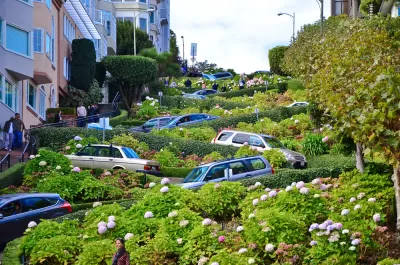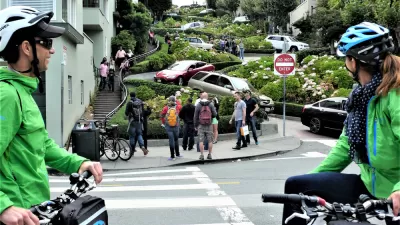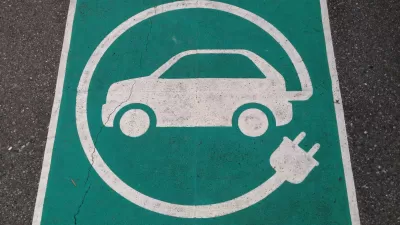If Gov. Gavin Newsom signs legislation by San Francisco Assemblyman Phil Ting, motorists who want to drive the 'world's most crooked street,' a huge tourist draw, will be forced to participate in a pilot 'reservation and pricing program.'

While not exactly 'Manhattan-style congestion pricing,' where drivers headed south of 60th Street will be subject to a hefty toll come January 2021, the Lombard Street 'reservation fee' had to clear the same legislative hurdle, as the state Assembly press release (source article) indicates.
The bill by Assemblymember Phil Ting (D-San Francisco) is necessary because existing law prohibits a local agency from imposing a tax, permit fee, or other charge for the use of its streets or highways.
The bill, "AB 1605: City and County of San Francisco: Crooked Street Reservation and Pricing Program," passed the Assembly on a 54-23-2 vote on Thursday. Gov. Newsom (D), the city's mayor from 2004 to 2011, has until Oct. 13 to sign or veto it. If he signs, the next step would be in the hands of the Board of Supervisors of the City and County of San Francisco, according to the bill's text:
This bill would authorize the Board of Supervisors of the City and County of San Francisco by ordinance to conduct a reservation and pricing pilot program for vehicles that use the “Crooked Street,” which the bill would define to mean the portion of Lombard Street located between Leavenworth Street and Hyde Street in the City and County of San Francisco.
Before the board of supervisors adopts an ordinance to conduct the pilot program, the bill would require the board of supervisors to make certain findings and to conduct at least 2 public outreach meetings or hearings...
The reservation program would be an all-electronic system, supported by a website, mobile app, and possible on-street kiosks to enable reservations, payments, and user support, according to the Sept. 4 legislative analysis. It states that the "current plan is for a staff [sic] onsite to check reservations, through paper and electronic means, and help direct vehicles, operating from 9:00 a.m. to 9:00 p.m. and cost $5 on weekdays and $10 on weekends and holidays."
Unlike the Manhattan plan and all other cordon pricing schemes being considered by large cities in the U.S., including San Francisco, AB 1605 encountered no formal opposition. Yet pricing streets, even more so than parking, is inherently controversial, explaining why 28 percent of legislators in both chambers opposed the bill.
Other alternatives considered
The seven-year pilot program fits the description of road pricing, a type of tolling, which was one of several considerations to deal with the street congestion, as noted in a September 2016 post on a study conducted by the San Francisco County Transportation Authority:
After a year researching how other tourist destinations handle similar problems, the study is now exploring solutions—including barring cars and turning the area into a pedestrian-only plaza...Other proposals include hiring a mass of parking and safety officers, requiring reservations, and charging a toll.
The fact that a car ban was not selected, yet was considered, is noteworthy. In essence, the authority chose a market-based measure to manage demand over the simpler, but arguably more extreme, ban, which presumably would not have required state legislation.
Assuming the governor signs AB 1405, chalk this pricing initiative up as a win for the Transportation Authority and Assemblyman Ting. The authority's Pricing & Incentives webpage lists three additional, ongoing projects:
- Carpool and express lanes on freeways
- Downtown congestion pricing
- A toll to enter and exit Treasure Island
Additional reading:
- Tourists May Soon Have to Pay to Drive San Francisco’s Lombard Street, Associated Press, Sept. 6, 2019
- Gridlock At The World-Famous “Crooked Street” Prompts Legislation To Soothe Residents' Woes, San Francisco Magazine, Aug. 23, 2019
Related in Planetizen:
-
Crowds of Pedestrians Prompt Lombard Street Study, September 22, 2016
-
SF's Congestion Pricing Plan Advances, November 15, 2010
Hat tip to Nannette Miranda.
FULL STORY: Ting Proposal for Reservation & Pricing System On World Famous Lombard Street Heads to the Governor

Planetizen Federal Action Tracker
A weekly monitor of how Trump’s orders and actions are impacting planners and planning in America.

Congressman Proposes Bill to Rename DC Metro “Trump Train”
The Make Autorail Great Again Act would withhold federal funding to the system until the Washington Metropolitan Area Transit Authority (WMATA), rebrands as the Washington Metropolitan Authority for Greater Access (WMAGA).

The Simple Legislative Tool Transforming Vacant Downtowns
In California, Michigan and Georgia, an easy win is bringing dollars — and delight — back to city centers.

The States Losing Rural Delivery Rooms at an Alarming Pace
In some states, as few as 9% of rural hospitals still deliver babies. As a result, rising pre-term births, no adequate pre-term care and "harrowing" close calls are a growing reality.

The Small South Asian Republic Going all in on EVs
Thanks to one simple policy change less than five years ago, 65% of new cars in this Himalayan country are now electric.

DC Backpedals on Bike Lane Protection, Swaps Barriers for Paint
Citing aesthetic concerns, the city is removing the concrete barriers and flexposts that once separated Arizona Avenue cyclists from motor vehicles.
Urban Design for Planners 1: Software Tools
This six-course series explores essential urban design concepts using open source software and equips planners with the tools they need to participate fully in the urban design process.
Planning for Universal Design
Learn the tools for implementing Universal Design in planning regulations.
Smith Gee Studio
City of Charlotte
City of Camden Redevelopment Agency
City of Astoria
Transportation Research & Education Center (TREC) at Portland State University
US High Speed Rail Association
City of Camden Redevelopment Agency
Municipality of Princeton (NJ)





























